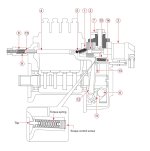Ritchey> you seem to be misinformed. The injection pump is an entity unto itself, and limited by the screw the engine manufacturer installs. Not adjusted on a bench by the injection pump folks. When you send a pump in for service, the screw stays in the engine block.
The pump folks SETS the fuel at full and CHECKS idle and starting. The full load fuel SCREW is set by the engine manufacturer at the factory. Due to gear train wear, fuel quality and injector condition, the fuel may not be getting a complete burn, hence the need to
"turn it up".. I'm not saying this is the correct method to remedy a low power condition, I'm just answering the question asked..
You are correct in the effective plunger stroke.. and too much fuel will actually lower the hp of the engine by flooding it w/ fuel.
